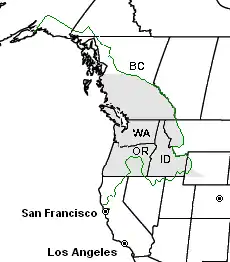Portal:Pacific Northwest
The Pacific Northwest Portal Scattered patches of subalpine fir grow below glaciers and permanent snowfields on the south slope of Mount Rainier in the Cascades ecoregion The Pacific Northwest (PNW), sometimes referred to as Cascadia, is a geographic region in western North America bounded by its coastal waters of the Pacific Ocean to the west and, loosely, by the Rocky Mountains to the east. Though no official boundary exists, the most common conception includes the U.S. states of Oregon, Washington, and Idaho, and the Canadian province of British Columbia. Some broader conceptions reach north into Alaska and Yukon, south into northern California, and east into western Montana. Other conceptions may be limited to the coastal areas west of the Cascade and Coast mountains. The variety of definitions can be attributed to partially overlapping commonalities of the region's history, culture, geography, society, ecosystems, and other factors. The Northwest Coast is the coastal region of the Pacific Northwest, and the Northwest Plateau (also commonly known as "the Interior" in British Columbia and the Inland Northwest in the United States) is the inland region. The term "Pacific Northwest" should not be confused with the Northwest Territory (also known as the Great Northwest, a historical term in the United States) or the Northwest Territories of Canada. The region is sometimes referred to as Cascadia, which, depending on the borders, may or may not be the same thing as the Pacific Northwest. The region's largest metropolitan areas are Greater Seattle, Washington, with 4 million people; Metro Vancouver, British Columbia, with 2.84 million people; and Greater Portland, Oregon, with 2.5 million people. The culture of the Pacific Northwest is influenced by the Canada–United States border, which the United States and the United Kingdom established at a time when the region's inhabitants were composed mostly of indigenous peoples. Two sections of the border—one along the 49th parallel south of British Columbia and one between the Alaska Panhandle and northern British Columbia—have left a great impact on the region. According to Canadian historian Ken Coates, the border has not merely influenced the Pacific Northwest—rather, "the region's history and character have been determined by the boundary". (Full article...) Selected article -Seattle–Tacoma International Airport (IATA: SEA, ICAO: KSEA, FAA LID: SEA), branded as SEA Airport and also referred to as Sea–Tac (/ˈsiːtæk/), is the primary commercial airport serving the Seattle metropolitan area in the U.S. state of Washington. It is in the city of SeaTac, which was named after the airport's nickname “Sea-Tac”, approximately 14 miles (23 km) south of Downtown Seattle and 18 miles (29 km) north-northeast of Downtown Tacoma. The airport, which is the busiest in the Pacific Northwest region of North America, is situated between Portland, Oregon and Vancouver, British Columbia, and is owned by Port of Seattle. The entire airport covers an area of 2,500 acres (3.9 sq mi; 10 km2), much smaller than other U.S. airports with similar annual passenger numbers. The airport has flights to cities throughout North America, Oceania, Europe, the Middle East, and Asia. It is the primary hub for Alaska Airlines, whose headquarters are near the airport. It is also a hub and international gateway for Delta Air Lines, which has expanded at the airport since 2011. , 31 airlines operate at SEA, serving 91 domestic and 28 international destinations. (Full article...)Selected biography -
George Edward Bruns (July 3, 1914 – May 23, 1983) was an American composer of music for film and television. His accolades include four Academy Award nominations, and three Grammy Award nominations. He is mainly known for his compositions for numerous Disney films spanning from the 1950s until the 1970s, among them Sleeping Beauty (1959), One Hundred and One Dalmatians, The Absent-Minded Professor (both 1961), The Sword in the Stone (1963), The Jungle Book (1967), The Love Bug (1968), The Aristocats (1970), and Robin Hood (1973). A native of Sandy, Oregon, Bruns began playing piano at age six. After graduating from Oregon State University, he worked as a bandleader at the Multnomah Hotel in Portland before relocating to Los Angeles to further pursue a musical career. In 1953, Bruns was hired as a musical arranger at Walt Disney Studios, eventually going on to become the studio's music director, a role he served from the mid 1950s until his retirement in 1976. (Full article...)Largest cities of the Pacific Northwest
General images -The following are images from various Pacific Northwest-related articles on Wikipedia.
Did you know -
Indigenous peoplesRelated portalsCategoriesCategory puzzle Select [►] to view subcategories
Pacific Northwest British Columbia Culture of the Pacific Northwest Endemic fauna of the Pacific Northwest Flora of the West Coast of the United States Flora of the Northwestern United States Geography of the Pacific Northwest History of the Pacific Northwest Indigenous peoples of the Pacific Northwest Lichens of the Northwestern United States Northwestern United States People from the Pacific Northwest Pacific temperate rainforests Puget Sound region Religion in the Pacific Northwest Society of the Pacific Northwest Pacific Northwest transport templates WikiProjects
Tasks
Associated WikimediaThe following Wikimedia Foundation sister projects provide more on this subject:
Sources
Discover Wikipedia using portals
| |||||||||||||||||||||||||||||||||||||||||||||||||||||||||||



.jpg.webp)



.jpg.webp)





.jpg.webp)


















.jpg.webp)





